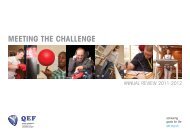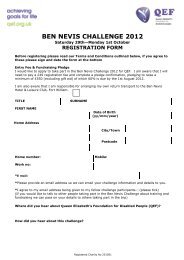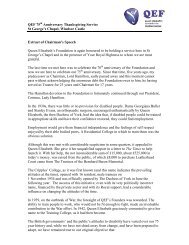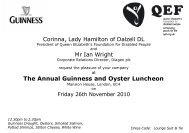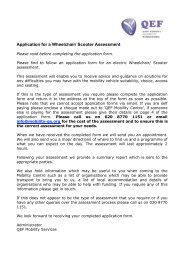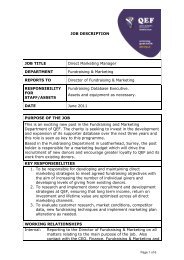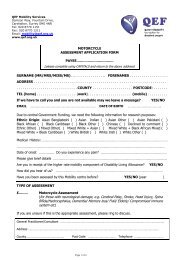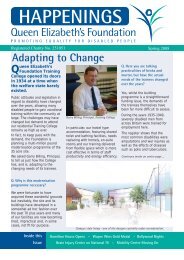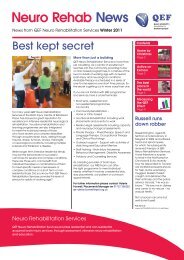An Introduction to Driving for Deaf 2012 - QEF
An Introduction to Driving for Deaf 2012 - QEF
An Introduction to Driving for Deaf 2012 - QEF
You also want an ePaper? Increase the reach of your titles
YUMPU automatically turns print PDFs into web optimized ePapers that Google loves.
ead you and watch the road at the same time. You will not be able <strong>to</strong> give<br />
instructions while the pupil is driving along. Wait until the car has s<strong>to</strong>pped at a<br />
quiet part of the road.<br />
When you speak <strong>to</strong> a deaf person, remember <strong>to</strong>:<br />
• Speak clearly<br />
• Do not shout<br />
• Keep your head still<br />
• Do not speak until the deaf person can see your lips clearly. Try <strong>to</strong> move<br />
your lips a little more than you normally do<br />
• Be patient<br />
It is vital <strong>to</strong> realise that lip-reading is largely guesswork because so many words<br />
look the same. For example, the sounds, M, B and P look exactly the same and<br />
the lip-reader cannot SEE any difference between the words PETER, BETTER<br />
and METER. There are thousands of such ambiguities – compare COLD, OLD,<br />
HOLD and GOLD. Lip reading is made more difficult because sounds such as N,<br />
T, D, K, L, G are ‘invisible’. The lips do not move when these sounds are made.<br />
Some deaf people are very good at lip reading so clear speech is important.<br />
Face <strong>to</strong> face conversation, demonstration, written notes and the use of visual<br />
aids will cover all requirements. Unsatisfac<strong>to</strong>ry response is likely <strong>to</strong> be the<br />
fault of the instruc<strong>to</strong>r rather than the learner.<br />
At the outset it is necessary <strong>to</strong> establish what is the best means of<br />
communication. For example, putting a thumb up will mean "good" whereas<br />
putting a thumb down will mean "bad".<br />
<strong>Introduction</strong> <strong>to</strong> Controls<br />
<strong>Introduction</strong> <strong>to</strong> controls of the vehicle, as is the practice, will be by<br />
demonstration when the car is stationary. Emphasis must be made <strong>to</strong> show<br />
which limb has <strong>to</strong> operate each control, as demonstration is the method which<br />
will be used <strong>to</strong> communicate. For instance, the right leg being the limb used<br />
<strong>for</strong> the accelera<strong>to</strong>r and the footbrake: tap your own right leg as you place it<br />
over the accelera<strong>to</strong>r and the footbrake. Similarly when demonstrating the use<br />
of the clutch, tap your own left leg as you demonstrate <strong>to</strong> the pupil how <strong>to</strong><br />
operate this pedal. This will establish <strong>to</strong> the pupil what is being asked when<br />
you tap either leg.<br />
Mirrors<br />
Explain the need <strong>for</strong> effective use; pointing first <strong>to</strong>wards the eyes and then <strong>to</strong><br />
the mirrors can be a good reminder.<br />
Steering<br />
<strong>QEF</strong> Mobility Services 10





